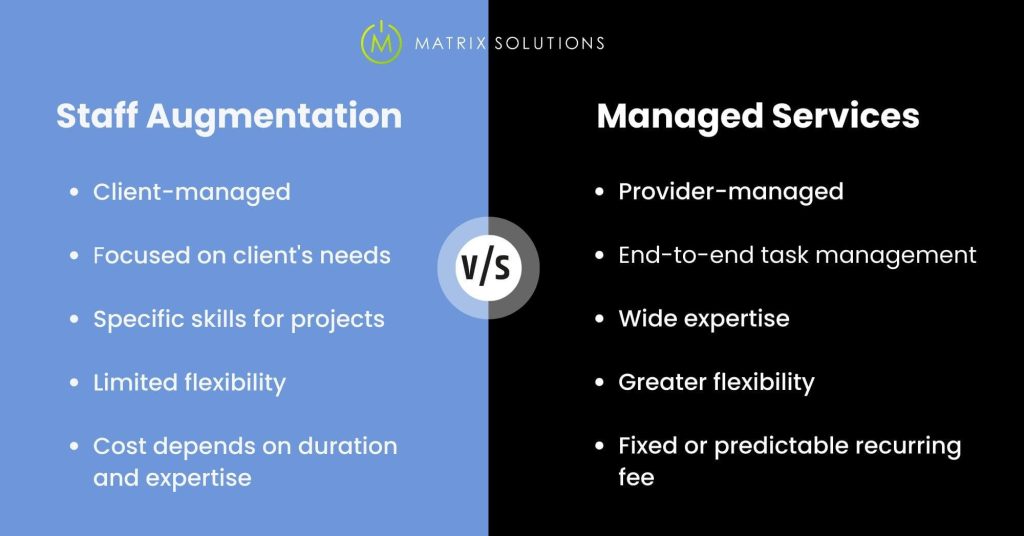Enterprises have a variety of outsourcing vs. staff augmentation options at their disposal for effective workforce management and goal attainment. They often must decide between two key models: staff augmentation vs. managed services. They use these models for their business operations and for managed IT solutions to address staffing and resource needs. In the era of surging remote work, outsourcing has become the preferred choice over in-house project management.
This comprehensive comparison explores the complexities of both approaches, showcasing the pros and cons of staff augmentation and managed services. It also explores the specific scenarios in which they excel.
What Does Staff Augmentation Mean?
Staff augmentation represents a strategic business practice wherein an organisation hires external personnel or highly skilled professionals to reinforce its in-house workforce for a finite duration. This approach empowers a company to promptly harness specialised expertise and expand its workforce for targeted projects or peak workloads without committing to long-term employment contracts.
What Does Managed Services Mean?
Managed services are a business model where an organisation outsources the management and maintenance of certain IT or operational functions to a third-party service provider. They embrace several distinguishing features, including ongoing supervision, feedback mechanisms, and high adaptability to the business’s needs.
Staff Augmentation Model
The staff augmentation model entails the integration of additional personnel into an established team, facilitating dynamic scalability in response to workload fluctuations. This approach enables the team to acquire supplementary skills outside the core team’s composition. Careful integration will facilitate seamless collaboration and communication between the core team and augmented staff. This, in turn, minimises challenges and maximises overall success in the staff augmentation model.
We have highlighted the benefits and drawbacks of the staff augmentation model below:
Benefits of Staff Augmentation
Staff augmentation advantages are numerous, especially for businesses looking to enhance their workforce with external talent and expertise. These benefits include:
- Scalability: Scale your team up or down as needed.
- Cost Efficiency: Eliminates the need for long-term commitments.
- Access to Specialised Skills: Valuable for short-term or specialised projects.
- Faster Project Delivery: Accelerate project development and delivery.
- Reduced Recruitment Burden: Bypass job ads, interviews, and onboarding.
- Flexibility: Acquire skills, fill staffing gaps, and control hiring terms.
- Risk Mitigation: Free external resources during business uncertainty.
- Geographical Flexibility: Develop unique talents globally.
- Knowledge Transfer: Boosts skills with fresh ideas and practices.
- Focus on Core Competencies: Outsourcing non-essential tasks.
- Improved Work-Life Balance: Reduces employee workload.
- Enhanced Productivity: Leverages specialised skills and resources.
Drawbacks of Staff Augmentation
Before diving into the specifics, it’s important to understand that staff augmentation has some drawbacks that all organisations must consider. Here are some of the common drawbacks of staff augmentation:
- Integration: May lead to communication and collaboration issues.
- Skill and Quality Variability: Inconsistent skill levels can result in a lack of cohesion.
- Limited Company Knowledge: May hinder in making informed decisions at work.
- Short-term Focus: Less dedication to the company’s mission and values.
- Training and Onboarding Costs: Can be time-consuming and costly.
- Overhead Costs: Managing augmented staff can add administrative overhead.
- Dependency on External Talent: Can lead to a lack of in-house expertise development.
- Data Security Concerns: Sharing company information can pose data security risks.
- Limited Ownership and Accountability: May lead to lower accountability for project outcomes.
- Potential for Conflicts of Interest: Simultaneous work with multiple clients may lead to conflicts of interest or divided loyalties.
- Cost Considerations: If external staff engagement is prolonged, it may become expensive.
Managed Services Model
A managed services model involves establishing an entirely new team through outsourcing. Outsourcing is not a one-dimensional, universal approach that can be applied similarly to every project or organisation. Instead, the effectiveness of outsourcing depends on various factors and the unique needs of a specific project or business.
In this model, the service provider manages IT services, freeing the client to focus on core activities. A service-level agreement (SLA) outlines terms, covering IT support, network management, cybersecurity, and managed cloud services. This provides a cost-effective way for businesses to access external expertise, ensuring reliable and secure critical systems.
Like staff augmentation, this model has various advantages and limitations. Let’s explore the managed services benefits and drawbacks to draw a clear picture as to which model is beneficial for your organisation:
Benefits of Managed Services
Managed services offer several benefits to organisations across various industries. Below, we delineate several key benefits associated with the adoption of managed services:
- Focus on Core Competencies: Can lead to improved productivity and competitiveness.
- Scalability: Can often scale their services up or down based on needs.
- Access to Expertise: Can lead to better performance, reliability, and innovation.
- 24/7 Support: Critical systems and applications are monitored and maintained at all times.
- Proactive Monitoring and Maintenance: Advanced monitoring tools to identify and address issues.
- Predictable Costs: Managed services pricing is more straightforward.
- Reduced Risk: Outsourcing can transfer some operational risks to the service provider.
- Improved Efficiency: Streamline IT operations and business processes, improving efficiency.
- Access to the Latest Technology: Service providers invest in the latest tech, sparing clients from constant capital investments.
- Vendor Management: Act as a single point of contact for various services.
Drawbacks of Managed Services
The demerits associated with managed services can have a substantial impact on the overall health of an organisation. Nevertheless, the benefits of managed services overshadow their limitations and are considered a better choice. Here are some common drawbacks of managed services:
- Cost: Managed services can be costly.
- Limited Control: You may have less control over the systems and processes.
- Dependency: Depending on a third party can disrupt your operations.
- Security Concerns: There’s a potential security risk with your data and systems.
- Integration Challenges: May not seamlessly integrate with your existing infrastructure or systems.
- Communication and Responsiveness: You may encounter delays in getting support or addressing issues.
- Contractual Commitments: Long-term commitments can be a drawback if your organisation’s needs change.
- Data Privacy and Compliance: MSPs handling your data can raise data privacy and compliance concerns.
- Hidden Costs: MSPs may charge extra for services, support, or changes.
- Limited Expertise Transfer: May limit your team’s skill and knowledge growth in covered areas.
- Reliability and Downtime: MSPs strive for high reliability, but downtime risk can still disrupt your operations.
Key Differences between Staff Augmentation and Managed Services
Staff augmentation and managed services represent distinct approaches to outsourcing and obtaining essential talent or expertise to reinforce diverse business functions. Following a comprehensive analysis of the staff augmentation and managed services models, it is imperative to map out their primary differences. This exercise is instrumental in determining the most suitable model for your project’s specific needs. Here are the key differences between staff augmentation and managed services:
1. Ownership and Responsibility:
In staff augmentation, the client company maintains full ownership over the hired resources and is responsible for their management and supervision. Managed services mean a third-party provider fully handling specific tasks or processes, with the client outsourcing the function to achieve desired results.
2. Scope of Work:
Staff augmentation involves hiring professionals or teams to address skill gaps and enhance in-house capabilities, clearly focusing on the client’s needs. Managed services cover end-to-end management of tasks like IT, customer support, and security, with the MSP handling design, implementation, and maintenance.
3. Expertise and Skills:
Staff augmentation is suitable for obtaining specific skills or expertise for a short or long-term project. Managed service providers offer a wide range of expertise and ensure the availability of skills to meet service level agreements (SLAs) and objectives.
4. Flexibility:
Managed services provide greater flexibility as they offer a comprehensive solution with outsourced expertise, allowing businesses to focus on core activities. Unlike staff augmentation, managed services ensure a more adaptable and scalable approach, enhancing operational agility and efficiency.
5. Cost Structure:
Clients pay augmented staff based on hours, months, or projects, with costs tied to hired resources’ duration and expertise. Managed services often involve a fixed or predictable cost structure, where the client pays a recurring fee for the entire service.
6. Risk and Accountability:
Managed services provide a higher level of accountability as the service provider assumes responsibility for the entire IT function, reducing the client’s risk exposure. In contrast, staff augmentation best practices involve hiring additional personnel without transferring the same level of accountability, making managed services a superior choice for comprehensive and risk-mitigated support.
| Aspects |
Staff Augmentation |
Managed Services |
|
Ownership & Responsibility |
Client-owned, client-managed |
Provider-owned, provider-managed |
|
Scope of Work |
Skill enhancement, focused on client’s needs |
End-to-end task management, design, implementation, and maintenance |
|
Expertise & Skills |
Specific skills for projects |
Wide expertise, meeting SLAs |
|
Flexibility |
Limited, focused on client needs |
Greater flexibility, adaptable and scalable |
|
Cost Structure |
Variable based on duration and expertise |
Fixed or predictable recurring fee |
|
Risk & Accountability |
Client retains accountability |
Provider assumes accountability, lower client risk |

When to Use Staff Augmentation?
Staff augmentation offers a valuable resource for businesses in various scenarios. To better understand when to consider this approach, exploring specific situations where staff augmentation can provide significant benefits and support business objectives is crucial.
1. While Seeking Specialised Skills and Expertise
Staff augmentation presents a versatile solution, enabling businesses to effectively manage development projects without being constrained by their existing resources.
2. Addressing Temporary Workload Spikes
Many businesses undergo fluctuations in their workload due to changing seasons, prompting the need for seasonal hiring. With staff augmentation, companies can ensure they have the necessary support during peak seasons without the need for downsizing when workloads decrease.
3. For Short-term Projects Beyond Your Expertise
Technology is crucial in today’s business world. For businesses with specific tech projects, staff augmentation offers specialised teams without the hiring hassle, ensuring project success.
4. Addressing Talent Gaps in Your Full-Time Team
Staff augmentation is a cost-effective solution for lengthy hiring and covering staff leaves. It helps small tech businesses attract and retain talent in a competitive industry with a 22% projected growth in software developer positions by 2029.
5. When Cost Saving is a Priority
Outsourcing IT services as needed is a cost-effective way to avoid ongoing expenses like employee benefits. Recent surveys show that 70% of executives prioritise cost reduction through strategic partnerships with staffing service providers, leading to improved operational efficiency.
When Not to Use Staff Augmentation?
It is not suitable to depend on staff augmentation when the specific expertise required is integral to the core business strategy. Relying solely on augmented staff might lead to communication gaps and a lack of project ownership. Careful consideration of an organisation’s specific needs and goals is crucial in determining the most appropriate approach.
Here are two situations where staff augmentation may not be the optimal choice for your company:
1. When Resources Are Ready
If your team is well-equipped, conduct a cost-benefit analysis before deciding on staff augmentation to align with your goals and budget.
2. When You Need a Full-Time Team Member
Staff augmentation provides a cost-effective, temporary staffing solution for 3 months to 2 years. Consider permanent hiring if your company is growing and needs a full-time Quality Assurance (QA) professional. In the meantime, use IT staffing models for specific projects or interim needs while you search for a dedicated QA engineer.
When to Use Managed Services?
Evaluate your goals and needs when you’re considering managed services. Managed services can outsource tasks and responsibilities in various scenarios. Here are some common situations in which using managed services can be beneficial:
Lack of Expertise
When your business lacks the expertise to manage certain systems, technologies, or processes in-house, managed services provide essential specialised IT, cybersecurity, and database management skills, helping businesses thrive in the digital age.
Long-Term Partnership
It is best to opt for managed services if your organisation seeks a long-term commitment to technology management, as they often establish ongoing contractual relationships.
Ongoing IT Management
For organisations needing ongoing, proactive management of IT infrastructure, cybersecurity, and support services, Managed Service Providers (MSPs) offer a comprehensive solution that can enhance your operational efficiency and security posture.
Data Backup and Recovery Solutions
Managed service providers offer consistent backup and recovery solutions to shield against potential data loss, ensuring the utmost protection of valuable information. So, businesses and organisations use MSPs when they are concerned with data security and recovery.
Cybersecurity and Compliance
Managed service providers stand out for their expertise in continuous monitoring and safeguarding against threats, ensuring strong data security and unwavering commitment to regulatory standards. As a result, opting for managed services becomes the top choice when prioritising cybersecurity and compliance.
Predictable Cost Structure
Managed Service Providers (MSPs) provide reliable, budget-friendly IT support options that simplify financial planning, reduce risks, and enhance business productivity.
When Not to Use Managed Services?
It is best not to use managed services when immediate, hands-on control over every aspect is important. However, it’s crucial to note that the numerous benefits of managed services often outweigh the drawbacks. Managed IT services offer a more holistic, proactive, and efficient approach compared to the more limited scope of staff augmentation.
Nonetheless, here are some instances where you might consider not to use managed services:
Basic IT for Small Entities
Managing tasks in-house or on-demand is cost-effective for small organisations with basic IT needs. As your company grows, consider the scalability and long-term benefits of transitioning to managed services for reliable support.
Specific or Unique Requirements
If your organisation has unique IT needs, third-party managed services might not be suitable. You may need to retain full control over your IT operations in such cases, as third-party services often provide standardised solutions that may not align with the organisation’s needs.
Data Sensitivity and Security Concerns
If your company deals with sensitive data, you might hesitate to use external IT services due to security and compliance concerns. In such cases, you should keep data security in-house.
Short-term Projects
For short-term IT needs or projects, consider hiring specialised IT professionals or consultants for flexibility and efficiency instead of committing to a long-term managed IT services contract.
Highly Efficient Existing Team
If your skilled in-house IT team can manage your IT infrastructure effectively, you may not need managed IT services, which would be redundant and costly in such cases.
Lack of Trust
Consider maintaining an internal IT team if you require greater confidence in the capabilities or reputation of a managed service provider.
Staff Augmentation vs. Managed Services: Which to Choose?
Opting for managed services can be ideal when launching a startup or developing a digital product for an existing business. On the other hand, staff augmentation is a viable option to scale your development team. Staff augmentation also proves beneficial when dealing with tasks or technologies in which your in-house team needs more expertise. Matrix Solutions provides world-class managed IT services so you can focus on your business without stress.
Whatever you choose should align with your organisation’s specific needs and objectives. When uncertain and facing a decision, consider these key factors to determine which option best suits your circumstances.
Factors Influencing Your Choice
When choosing between temporary staffing vs. managed services, the factors to consider will help you make an informed decision that aligns with your organisation’s goals and resources. The following are the key factors that play an important role in determining what to choose amongst staff augmentation and managed IT services:
1. Project Scope and Duration
Opt for staff augmentation for short-term or project-specific needs and managed services for ongoing IT requirements, including infrastructure management, IT support options, and 24/7 monitoring.
2. Cost Constraints
Staff augmentation offers flexibility for IT resource management under budget constraints, while managed services suit organisations with steady IT needs due to predictable monthly fees.
3. In-house Expertise
If your organisation has an in-house IT team, staff augmentation can boost their capabilities for specific projects. Managed services offer comprehensive IT support options if you need more in-house expertise.
4. Scalability
Staff augmentation provides flexible hiring and release of temporary staff, while managed services often involve fixed service level agreements, limiting resource allocation flexibility.
5. Level of Control
Staff augmentation offers direct control over project details and decision-making, while managed services providers take full responsibility for IT management, reducing direct control but freeing up internal resources.
6. Risk Management
Staff augmentation puts the onus on the organisation to manage risk and compliance for tailored solutions. Managed service providers focus on risk mitigation, security, compliance, and best practices, offering comprehensive solutions for those prioritising these aspects.
7. Core Business Focus
For streamlined IT management, choose managed services. If you want more control, go for staff augmentation.
Conclusion
To choose between staff augmentation and managed services, assess project needs, scalability, budget, and risk tolerance to align with your goals. Whether for short-term projects or ongoing functions, pick the strategy that best fits your business.
This decision can improve efficiency, cost-effectiveness, and success in the competitive business landscape. Let Matrix Solution handle the work if you’re considering outsourcing but find it complex. Contact us now for top-notch managed IT services in Sydney, designed to scale with your business needs while ensuring reliability, security, and efficiency.
Ready to Transform Your Business with Managed IT Services?
Discover the Key to Efficiency and Success With Matrix Solutions’ Managed IT Services.
FAQs on Staff Augmentation vs. Managed Services
What is Staff Augmentation, and how does it differ from Managed Services?
Staff augmentation is hiring temporary professionals or teams for short-term projects with full control. At the same time, managed services involve outsourcing functions to third-party providers for ongoing tasks, relinquishing day-to-day control.
When should a company choose Managed Services over Staff Augmentation?
An organisation should choose managed services when they need ongoing, specialised expertise and support, while staff augmentation is better for short-term, project-based needs or temporary in-house expertise.
How do Staff Augmentation and Managed Services impact project flexibility and control?
Staff augmentation enhances project control and flexibility by directly managing additional resources. Managed services can reduce control but offer scalability and expertise with the project’s service provider operating.
How can a company decide whether Staff Augmentation or Managed Services is the better fit for its specific needs?
For short-term and specific requirements, choose staff augmentation to optimise your workforce management. For long-term and ongoing support, opt for managed services, which allow you to focus on core activities. For deciding your right choice, take into account factors such as project duration, complexity, and in-house expertise for a seamless strategic approach to your staffing needs.
How does cost differ between Staff Augmentation and Managed Services?
Staff augmentation costs vary with projects or hourly rates, offering flexibility. The cost of managed services features fixed monthly fees for cost predictability. At the same time, staff augmentation offers control with potential upfront costs, and managed services provide ongoing support without significant initial investments.
Which is better for ongoing IT management and support – staff augmentation or managed services?
Managed services are better for ongoing IT management and support, as they provide consistent, proactive, and comprehensive services, often with fixed monthly fees, ensuring a stable support structure.
Which model provides better scalability for long-term growth and expansion?
Managed services typically provide better scalability for long-term growth and expansion. They are designed to adapt to your evolving IT needs and can offer a more seamless transition as your business grows, making them well-suited for long-term scalability.
Which approach is typically more cost-effective for 24/7 IT support and monitoring?
Managed services are typically more cost-effective for 24/7 IT support and monitoring. They often include 24/7 support as part of their standard services, and the fixed monthly fees provide cost predictability, making them a cost-effective choice for continuous support and monitoring.
Also Read. Managed Services vs Outsourcing: Know the Difference



